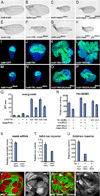Mask is required for the activity of the Hippo pathway effector Yki/YAP
- PMID: 23333314
- PMCID: PMC4089957
- DOI: 10.1016/j.cub.2012.12.033
Mask is required for the activity of the Hippo pathway effector Yki/YAP
Abstract
The Drosophila Yorkie (Yki) protein and its mammalian homolog Yes-associated protein (YAP) are potent growth promoters, and YAP overexpression is associated with multiple types of cancer. Yki and YAP are transcriptional coactivators and function as downstream effectors of the Hippo tumor suppressor pathway. The regulation of Yki and YAP by the Hippo signaling pathway has been extensively investigated; however, how they regulate gene expression is poorly understood. To identify additional regulators of Yki activity, we performed a genome-wide RNAi screen in Drosophila S2 cells. In this screen, we identified the conserved protein Mask (Multiple ankyrin repeats single KH domain) as a novel promoter of Yki activity in vitro and validated this function in vivo in Drosophila. We found that Mask is required downstream of the Hippo pathway for Yki to induce target-gene expression and that Mask forms complexes with Yki. The human Mask homolog MASK1 complexes with YAP and is required for the full activity of YAP. Additionally, elevated MASK1 expression is associated with worsened outcomes for breast cancer patients. We conclude that Mask is a novel cofactor for Yki/YAP required for optimal Yki/YAP activity during development and oncogenesis.
Copyright © 2013 Elsevier Ltd. All rights reserved.
Figures




Comment in
-
Cell signalling: A new Hippo pathway component.Nat Rev Mol Cell Biol. 2013 Apr;14(4):196. doi: 10.1038/nrm3534. Epub 2013 Feb 20. Nat Rev Mol Cell Biol. 2013. PMID: 23422888 No abstract available.
-
Cell signalling: a new Hippo pathway component.Nat Rev Mol Cell Biol. 2013 Apr;14(4):196. Nat Rev Mol Cell Biol. 2013. PMID: 23847779 No abstract available.
References
-
- Huang J, Wu S, Barrera J, Matthews K, Pan D. The Hippo signaling pathway coordinately regulates cell proliferation and apoptosis by inactivating Yorkie, the Drosophila Homolog of YAP. Cell. 2005;122:421–434. - PubMed
MeSH terms
Substances
Grants and funding
LinkOut - more resources
Full Text Sources
Other Literature Sources
Molecular Biology Databases

